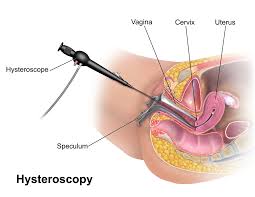Hysteroscopy
Home-> services-> hysteroscopy

Hysteroscopy
What Is Hysteroscopy?
Hysteroscopy is a procedure carried out to examine & inspect the inside of the female reproductive organs such as the uterus. It’s a procedure in which the doctor inserts a small, lighted instrument known as the hysteroscope, through the patient’s natural orifices. This instrument relays video images on the screen, which helps the doctor to inspect the inner organs of the patient.
Why Is Hysteroscopy Performed?
Hysteroscopy may be performed to investigate symptoms, diagnose conditions and treat conditions.
Following are the conditions which are diagnosed or treated with the help of hysteroscopy
Fibroids, also known as uterine myomas, are compact and firm tumors that are made of smooth muscle cells and fibrous connective tissue which develop in the uterus. In 99% percent of the cases such tumors are benign in nature. Hysteroscopy is generally used in the case of submucosal fibroid i.e. when the fibroid is present in the womb.
Uterine Polyps:
Uterine polyps are surgically removed with hysteroscopy. These polyps are benign growths attached to uterine lining. Overgrown endometerium cells lead to uterine polyps. The polyps formed can range from few millimeters to few centimeters. They generally occur within the uterus, but sometimes they may slip into the vagina through the cervix—the lowermost part of the uterus.
Adhesiolysis is the removal of adhesions. An adhesion is nothing but a band of scar tissue which initially develops as a part of the human body’s repair mechanism in response to any tissue disturbances, for instances due to previous surgeries.
In addition to the above conditions, chronic pelvic pain, repeated miscarriages and heavy menstrual periods are investigated with the help of hysteroscopy.
Hysteroscopy Procedure
During the hysteroscopy the doctor may or may not administer anesthesia depending on the purpose of the hysteroscopy and extent of the condition. The following steps are carried out during the procedure:
- The doctor will ask you to lie down in a position similar to the one during a pelvic examination – your legs will be provided support and the lower half of your body will be covered by sheet.
- Sometimes an instrument called as speculum is inserted into the vaginal opening so that it remains open.
- An antiseptic solution is used to clean the vagina and the cervix.
- The hysteroscope is passed into the womb, this may cause some cramping.
- Fluid is pumped into the uterus, so that the surgeon can see things clearly.
- The hysteroscope relays images to a monitor, which helps the doctor to indentify abnormalities, if there are any.
- If hysteroscopy is performed to treat a condition, such as fibroids, the doctor will pass the instruments along with the hysteroscope. These instruments are used to burn or cut the abnormality.
How Long Will It Take To Recover From A Hysteroscopy?
A hysteroscopy maybe performed for various diagnostic or operative reasons; therefore recovery time can vary extensively depending upon the reason why the procedure is performed. In many cases, it is an outpatient procedure, i.e. the patient can leave on the same day. But this may vary according to purpose of hysteroscopy & the extent of the condition. In some cases, you can eat & drink water within hours after the operation. Some women return to their normal work routine on the same day, but if you have been administered anesthesia, it’s advised to take a day off. Again, the time period for recovery may vary according to the purpose of hysteroscopy and extent of the condition.